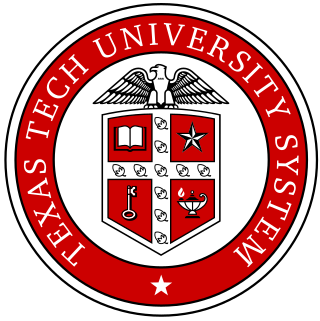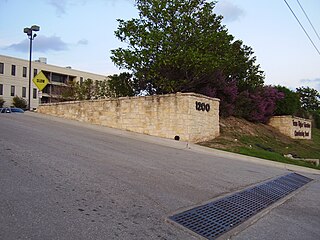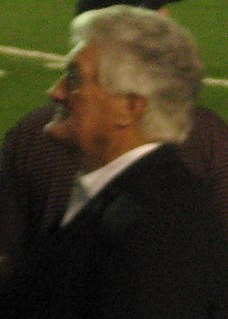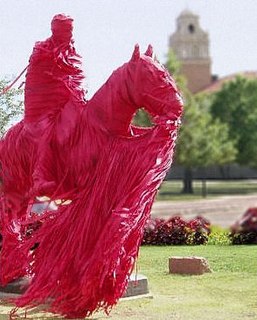
The history of Texas Tech University dates back to the early 1880s, but the university was not established until 1923.

The history of Texas Tech University dates back to the early 1880s, but the university was not established until 1923.
The call to open a college in West Texas began shortly after the arrival of settlers in the area in the 1880s. [1] [2] In 1917, the Texas legislature passed a bill creating a branch of Texas A&M to be located in Abilene. [3] However, the bill was repealed two years later during the next session after it was discovered that Governor James E. Ferguson had falsely reported the site committee's choice of location. After new legislation passed in the state house and senate in 1921, Governor Pat Neff vetoed it, citing hard financial times in West Texas. Furious about Neff's veto, some in West Texas went so far as to recommend that West Texas secede from the state. [4]
In 1923, the legislature decided that, rather than a branch campus, an entirely new university would better serve the needs of the region. [5] On February 10, 1923, Neff signed the legislation creating Texas Technological College, and in July of that year a committee began searching for a site. [4] When the members of the committee visited Lubbock, they were overwhelmed to find residents lining the streets to show support for the idea of hosting the institution. [6] [7] That August, Lubbock was chosen on the first ballot over other area towns, including Floydada, Plainview, and Sweetwater. [6]

Construction of the college campus began on November 1, 1924. [2] Ten days later, the cornerstone of the Administration Building was laid in front of a crowd of twenty thousand people. Governor Pat Neff, Amon G. Carter, Reverend E. E. Robinson, Colonel Ernest O. Thompson, and Representative R. M. Chitwood spoke at the event. [8] With an enrollment of 914 students—both men and women—Texas Technological College opened for classes on October 1, 1925. [9] [10] [11] It was originally composed of four schools—Agriculture, Engineering, Home Economics, and Liberal Arts. [5]
During the 1926 football season, head football coach, E. Y. Freeland, and assistant coach, Grady Higginbotham unveiled the first version of the Double T logo. [12] It was first used on the football players sweaters for the inaugural season. [13] [14]
Texas Tech grew slowly in the early years. Military training was conducted at the college as early as 1925, but formal Reserve Officers' Training Corps training did not commence until 1936. By 1939, the school's enrollment had grown to 3,890. Though enrollment declined during World War II, Texas Tech trained 4,747 men in its armed forces training detachments. [5] Following the war, in 1946, the college saw its enrollment leap to 5,366 from a low of 1,696 in 1943. [15]
By the 1960s, the school had expanded its offerings to more than just technical subjects. [16] The Faculty Advisory Committee suggested changing the name to "Texas State University", feeling the phrase "Technological College" was insufficient to define the scope of the institution. [17] While most students supported this change, the Board of Directors and many alumni, wanting to preserve the Double T logo, opposed it. [18] Other names—University of the Southwest, Texas Technological College and State University, [19] and The Texas University of Art, Science and Technology—were considered, [20] but the Board of Directors chose Texas Tech University, submitting it to the state legislature in 1964. A failed move by Governor John Connally to have the school placed into the Texas A&M University System, as well as continued disagreement and heated debate regarding the school's new name, kept the name change from being approved. [16] [17] In spite of objections by many students and faculty, the Board of Directors again submitted the change in 1969. It finally received the legislature's approval on June 6 and the name Texas Tech University went into effect that September. [20] All of the institution's schools, except Law, became colleges. [5] [21]
The university was integrated in 1961 when three African-American students were admitted. After its initial rejection of the students' enrollment and the threat of a subsequent lawsuit, the university enacted a policy to admit "all qualified applicants regardless of color". [22] The university offered its first athletic scholarship to a black student in 1967, when Danny Hardaway was recruited to play for the Red Raiders football team. [23] In 1970, Hortense W. Dixon became the first African-American student to earn a doctorate from the university. [24]
In the 1960s and 1970s, the university invested US$150 million in the campus to construct buildings for the library, foreign languages, social sciences, communications, philosophy, electrical and petroleum engineering, art, and architecture. Some other buildings were significantly expanded. [25] On May 29, 1969, the 61st Texas Legislature created the Texas Tech University School of Medicine. [26] The Texas Legislature expanded the medical school charter in 1979, creating the Texas Tech University Health Sciences Center. TTUHSC, which is now part of the Texas Tech University System, includes Schools of Allied Health Sciences, Medicine, Nursing, Pharmacy, and the Graduate School of Biomedical Sciences. It has locations in four Texas cities in addition to the main campus in Lubbock. [27]

In 1996, the Texas Tech Board of Regents created the Texas Tech University System. John Montford was selected as the first chancellor to lead the combined academic enterprise. [28] Regents Chair Edward Whitacre, Jr., stated that the move was made due to the size and complexity of the institution. "It's time", he said, "to take the university into the 21st century..." [25] The Texas Tech University system originally included Texas Tech University and Texas Tech University Health Sciences Center. On November 6, 2007, the Texas Legislature ratified an amendment to the Texas Constitution re-aligning Angelo State University with the Texas Tech University System. [29] Kent Hance, a former United States Congressman and Texas Tech University graduate, assumed the duties of chancellor on December 1, 2006. [30]
Even though growth continued at Texas Tech, the university was not immune to controversy. In 2003, a third-year student at the Texas Tech School of Law filed suit against the university over its policy on free speech zones, which restricted student speech to a single "free speech gazebo". [31] The following year, a federal judge declared the policy unconstitutional. [31] [32] [33]
To meet the demands of its increased enrollment and expanding research, the university has invested more than $548 million in new construction since 2000. It has also received more than $65.9 million in private donations. [25] In April 2009, the Texas House of Representatives passed a bill that will increase state funding for seven public universities. Texas Tech University is classified by the state as an "Emerging Research University" and is among the universities that will receive additional state funding for advancement toward "Tier 1" status. Three funds—the Research University Development Fund, the Texas Research Incentive Program, and the National Research University Benchmark Fund—have been established and will provide $500 million in grants and matching funds during fiscal years 2010 and 2011. [34] On September 2, 2009, the university announced that it had received private gifts totaling $24.3 million. Of these, $21.5 million are eligible for match under the Texas Research Incentive Program. [35]
In 2016, longtime faculty member and university administrator Lawrence Schovanec was named the 17th president of Texas Tech University. [36]
With the 2012 resignation of Guy Bailey as president to assume the presidency of his alma mater University of Alabama, Texas Tech immediately set about to select Bailey's successor. [37]

Lubbock is the 11th-most populous city in the U.S. state of Texas and the county seat of Lubbock County. With a population of 258,862 in 2019, the city is also the 83rd-most populous in the United States. The city is in the northwestern part of the state, a region known historically and geographically as the Llano Estacado, and ecologically is part of the southern end of the High Plains, lying at the economic center of the Lubbock metropolitan area, which has an estimated population of 327,424 in 2020.

Texas Tech University is a public research university in Lubbock, Texas. Established on February 10, 1923, and called Texas Technological College until 1969, it is the main institution of the five-institution Texas Tech University System. The university's student enrollment is the seventh-largest in Texas as of the Fall 2018 semester. As of Fall 2020, there were 40,322 students enrolled at Texas Tech. With over 25% of its undergraduate student population identifying as Hispanic, Texas Tech University is a designated Hispanic-serving institution (HSI).

Angelo State University is a public university in San Angelo, Texas. It was founded in 1928 as San Angelo College. It gained university status and awarded its first baccalaureate degrees in 1967 and graduate degrees in 1969, the same year it took on its current name. It offers 50 undergraduate programs and 31 graduate programs. It is the second-largest campus in the Texas Tech University System.

Lubbock Christian University (LCU) is a private Christian university associated with the Churches of Christ and located in Lubbock, Texas. Chartered originally as part of a grade school called Lubbock Christian School in 1954, the institution branched off as a junior college – Lubbock Christian College – in 1957. LCC became a senior college in 1972, then transitioned to university status in fall of 1987. LCU has 65 undergraduate degrees. A fall 2015 count showed 1,958 students enrolled at Lubbock Christian University, of which 462 are graduate students.

Jones AT&T Stadium, previously known as Clifford B. and Audrey Jones Stadium and Jones SBC Stadium, is an outdoor athletic stadium on the campus of Texas Tech University in Lubbock, Texas, United States, built in the style of Spanish Renaissance architecture. It is the home field of the Texas Tech Red Raiders football team of the Big 12 Conference.

The Texas Tech University Health Sciences Center (TTUHSC) is a public medical school based in Lubbock, Texas, with additional campuses in Abilene, Amarillo, Dallas, El Paso and the Permian Basin. TTUHSC serves more than 100 counties in the western portion of Texas. The university is a separate institution from Texas Tech University; both universities are among four universities that are part of the Texas Tech University System.

The Texas Tech Red Raiders and Lady Raiders are the athletic teams that represent Texas Tech University, located in Lubbock, Texas. The women's basketball team uses the name Lady Raiders, while the school's other women's teams use the "Red Raiders" name.

The Texas Tech University System is a state university system in Texas consisting of five separate universities in the state of Texas, of which three are universities, Angelo State University, Midwestern State University and Texas Tech University, and two are health institutions, Texas Tech University Health Sciences Center and Texas Tech University Health Sciences Center El Paso. The system is headquartered in the Administration Building on the Texas Tech University campus in Lubbock, Texas.

Texas Tech University Health Sciences Center El Paso is a public university focused on the health sciences and located in El Paso, Texas. It was founded in 1969 as a branch campus of the Texas Tech University Health Sciences Center and became a separate institution in 2013.
Smyer Independent School District is a public school district based in Smyer, Texas (USA) that serves students in east central Hockley County. There are two schools in the district: Smyer Secondary and Smyer Elementary (Grades.

Lubbock Avalanche-Journal is a newspaper based in Lubbock, Texas, United States. It is owned by Gannett.
The Rawls College of Business is the business school of Texas Tech University in Lubbock, Texas. Rawls Business offers curriculum for both undergraduate and graduate students and received its initial business accreditation in 1958 from the Association to Advance Collegiate Schools of Business (AACSB). Established in 1942, Texas Tech's business school was originally known as the Division of Commerce. In 1956, the school was renamed the College of Business Administration. Following a $25 million gift from alumnus Jerry S. Rawls in 2000, the school was renamed as Jerry S. Rawls College of Business Administration.

Texas has over 1,000 public school districts—all but one of the school districts in Texas are independent, separate from any form of municipal government. School districts may cross city and county boundaries. Independent school districts have the power to tax their residents and to assert eminent domain over privately owned property. The Texas Education Agency (TEA) oversees these districts, providing supplemental funding, but its jurisdiction is limited mostly to intervening in poorly performing districts.

David Wayne Parks was an American football wide receiver and tight end in the NFL. He was the first overall selection in the 1964 NFL Draft out of Texas Technological College. Parks was selected to three Pro Bowls, and was an All-Pro selection two times. In 1965 he captured the "triple crown" of receiving, leading the NFL in receptions, receiving yards, and receiving touchdowns. In 2008 Parks was selected to be enshrined in the College Football Hall of Fame.

The Double T is a logo that is the most readily identified symbol of Texas Tech University.

Victor Duane Payne Jr. was an American college basketball and college football coach. He was the head football coach at Abilene Christian College and Simmons University. Payne was also the basketball head coach at Texas Technological College—now known as Texas Tech University.

Texas Tech University traditions are an important part of the culture of Texas Tech University.
Tedd L. Mitchell is the fifth and current Chancellor of Texas Tech University System, a $2 billion state university system with an annual enrollment of approximately 55,000 students across four separate universities throughout Texas and 15 campuses worldwide. A doctor of medicine, Mitchell is also a published author and chairman for the Board of Trustees for the Cooper Institute., a Dallas-based health and wellness system founded by Dr. Kenneth H. Cooper